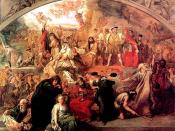William Shakespeare's
Sonnet 107
Nowadays William Shakespeare is renown as one of the world's greatest and most prolific dramatists of all times.Both tragedies such as "Romeo and Juliet", "Hamlet", "Anthony and Cleopatra", and light-hearted comedies like "The Taming of the Shrew" and "A Midsummer Night's Dream" are still box-office successes in theatres all around the globe.Yet, besides being a playwright, Shakespeare has also exercised his complex literary talents in poetry, appreciated in this domain especially due to his sonnets.
The sonnets written by Shakespeare generally follow the path opened by Petrarch in this literary genre two centuries before.These are actually poem forms consisting of 14 lines, each with 10 stressed and unstressed syllables known as iambic pentameter, with a set rhyme scheme of: a b a b c d c d e f e f g g. The rhymes may be ear-rhymes or eye-rhymes: an ear-rhyme is one that rhymes in sound, e.g.
"soul" and "control"; an eye-rhyme is one that rhymes by sight, e.g. "presage" and "age".
Shakespeare wrote 154 sonnets, all addressed directly to certain implicit readers-a young friend(his patron), a rival poet and a dark mistress.There have been numerous controversies in today's literary critique regarding the exact identities of the sonnets' subjects.
Among the most recurrent themes are beauty, love, witt, nobility, but also doom, fallibility and separation.Thus, Shakespeare doesn't deal solely with the pleasant aspects of life, but also exploits the flaws and downfalls of humanity.These very general themes are exploited in an extremely personal context.This correlation between the author's personal micro-universe and the macro-universe also appears in Sonnet 107, in which the poet seems to suggest a demise in his relationship with his patron.
Not mine own fears, nor the prophetic soul,
Of the wide world, dreaming...



Rating
Pretty good, just watch your grammar and avoid using words like, "nowadays."
1 out of 1 people found this comment useful.